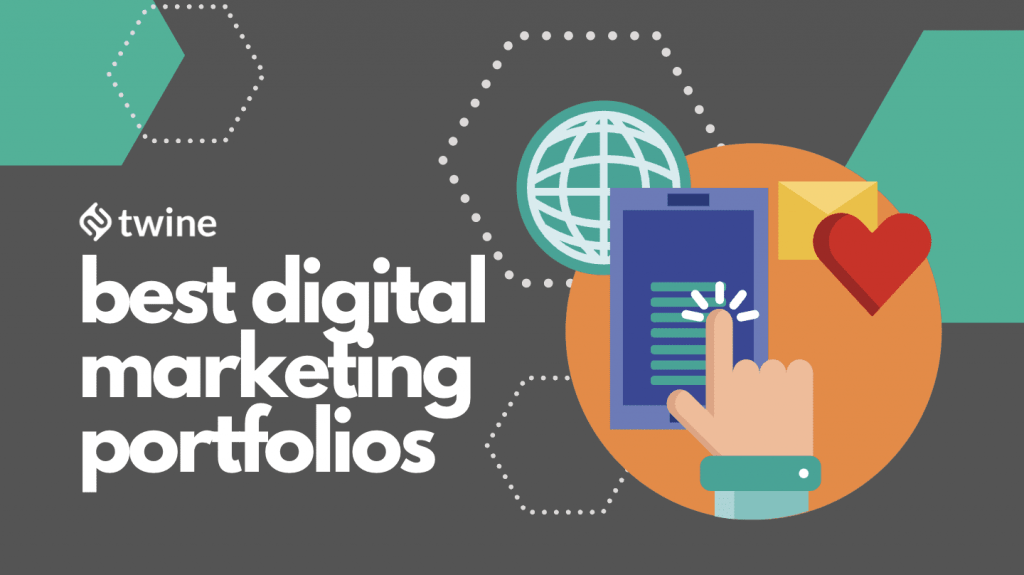
For more Web Tools, check out the Freelancer Toolkit…
Having a digital marketing portfolio is more important than ever in today’s business world. Your portfolio is a way to showcase your skills, abilities, and experience to potential employers and clients.
A strong digital marketing portfolio will help you land your dream job or score your first client. It can also be a helpful tool for networking and building relationships within the industry.
Whether you want to build a freelance digital marketing career or work for the company of your dreams, we have the answers for you.
In this article, we’ll show you the importance of having a digital marketing portfolio and how to make one that will help you stand out from the crowd.
What Is A Marketing Portfolio And Why Do You Require One?
A digital marketing portfolio is a collection of your best work. This can be in the form of blog posts, articles, infographics, or any other content that you’ve created. It can also include work that you’ve done for clients or employers, e.g. social media campaigns, marketing initiatives involving email, and website designs.
Your digital marketing portfolio should be an accurate representation of your skills and experience. It needs to be well-organized and easy to navigate. Why? So that potential clients can quickly find the information they’re looking for.
Think of your digital marketing portfolio as your own personal website or blog that showcases your best work. It needs to show potential clients what you can do – and what kind of results you can achieve.
There are a few key reasons why you need a digital marketing portfolio:
- It helps you land jobs and clients. Your digital marketing portfolio is like your resume, but, with more depth and creativity. It allows you to showcase your skills and experience in a way that’s much more engaging than a traditional resume. As a result, it can help you land jobs and clients more easily than if you didn’t have a portfolio.
- It makes you more credible. A digital marketing portfolio is a great way to build credibility and trust with potential employers. Showing them your previous work, as well as the results achieved, will allow them to see your ability.
- It sets you apart from the competition. With so many people competing for jobs, it’s important to find ways to set yourself apart from the crowd. A digital marketing portfolio is a great way to do this – not everybody has one!
Using Client Work On A Marketing Portfolio
A question that frequently comes up is whether or not you can feature client work on your marketing portfolio. The answer to this question depends on a few factors. An example may be the contract you have with the client, and their level of comfort with you sharing their work.
In some cases, it may be perfectly fine to showcase your work for a client on your portfolio. For instance, if you have an ongoing contract with them or if they’re comfortable with you sharing their work publicly, go for it.
In addition, if you’re specializing in a specific area of digital marketing (such as social media marketing or email marketing), it can be helpful to showcase your work in that area. This will give potential clients a better idea of the type of work you do and the results you can achieve.
However, there are also cases where it’s not appropriate to showcase client work on your portfolio. For example, if you don’t have permission from the client or if they prefer to keep their work private, then sharing their work is out of the question.
If you’re unsure whether or not you can showcase your work for a particular client on your portfolio, it’s always best to err on the side of caution. Get their permission before sharing anything.
What To Include In A Digital Marketing Portfolio
Marketing yourself online as a freelancer or agency does take some thinking to accomplish. The portfolio is one of the most important selling tools for every digital marketer. As such, it should include your best work and results to show off what you can do for potential employers or clients.
Here are some things that you should consider including in your digital marketing portfolio:
- Your “About” section. This is where you can tell potential employers or clients a little bit about yourself, your experience, and your skills. Include information such as your name, job title, years of experience, and links to your social media profiles.
- Work samples and case studies – This is the meat of your portfolio and where you’ll showcase your best work. Choose work that you’re proud of and that you feel shows off your skills and abilities. For each piece of work, including a brief description of what you did, the results you achieved, and any relevant screenshots or images.
- Contact information. Include your email address and/or phone number so that potential employers or clients can easily get in touch with you. You may also want to include links to your website or blog (if your portfolio is not an actual website).
Building A Marketing Portfolio Without Any Experience In The Field
The next question that might be running through your mind is, “What if I don’t have any experience in the field? Can I still build a portfolio?“
The answer is yes – you can.
If you don’t have any professional work experience, you can include other types of projects in your portfolio. For example, you could create a blog post or case study about a hypothetical situation and the steps you would take to solve it.
You could also include personal projects that you’ve done to improve your skills. For example, if you created a social media campaign for a friend’s business or designed an email marketing campaign for a local non-profit, there’s no harm in including this in your portfolio.
Including these types of projects will show potential clients that you’re serious about marketing, and that you have the skills to do the job.
At the very least, you’ll recieve testimonials that you can put in your portfolio, This will add more credibility to your work and give you a great stepping stone to more advanced work.
How To Create A Marketing Portfolio: A Step-By-Step Guide
Now that we’ve answered the question, “What is a digital marketing portfolio?” and gone over what should be included in one, it’s time to get into how you can actually create your own portfolio.
Here’s a step-by-step guide to help you build your own digital marketing portfolio.
1) Choose A Platform
The first step is to choose a platform to build your portfolio on, whether it’s for your freelance work or your full-service digital marketing agency. There are many different website builders and content management systems (CMS) that you can use. Some popular options include WordPress, Wix, Squarespace, and Weebly.
WordPress might seem a bit technical at first, but in the long run, it will be worth it cost wise, especially when for a modern website template you only pay once.
2) Add Your Content
The next step is to add your content to your website. This includes things like your “About” section, work samples, case studies, and contact information. Be sure to proofread everything before you publish it.
In addition, add marketing and freelancing lingo that only those on the inside would know. By doing so, you are showing that you’re up to date on the latest industry trends and have a good understanding of how marketing works.
3) Showcase Your Best Marketing Samples
The next step is to showcase your best marketing samples on your website. As we mentioned earlier, you should only include your best work so that potential employers or clients can see the quality of your work.
To make things easier for them, you can create a separate page on your website that’s dedicated to showcasing your marketing samples. You can also group them by skillset or project type. Using the right graphic design tools will really allow you to make your content look stunning and professional.
4. Publish Your Portfolio
The final step is to publish your portfolio and make it live for the world to see. Once you’ve proofread everything and added all of your content, hit the “publish” button and your portfolio will be live.
You can then start sharing it with potential employers, clients, or anyone else who might be interested in seeing your work. You can also take a leaf out of the marketing automation play book and use specific tools to help you manage how you market your portfolio. This will make it easier for clients to find the information they need and contact you.
Marketing Portfolio Examples
Let’s now have a look at some great examples of marketing portfolios:
#1 https://muradmurad.com/
This is a great portfolio that highlights digital marketing and freelancing skills.
From the great animations on the site to the various qualifications and detailed kills, it’s easy to see that this person is a marketing professional. There’s also a focus on the target audience that the person is trying to reach, which is a nice touch.
#2 https://mantolak.com/
Labeling himself as a creative marketer, Michael’s portfolio is a great example of how to present your work in an interesting way.
The simplistic yet highly matched design of the website is great, and it’s easy to navigate too. The case studies are also presented in an engaging way, with clear visuals and content that is easy to understand.
#3 https://www.vnmedias.net/
Victoria Nikolaeva brands herself as a game industry digital marketing manager.
What we like about her portfolio is the black and white design when it comes to her highlighting the skills that she has. The use of yellows and whites is also great for making the content pop.
#4 https://www.behance.net/emma_jane
When it comes to graphics design, Emma Jane’s portfolio is one of the best that we’ve seen. She has done a great range of work when it comes to social media. All the images shown on her portfolio are also high quality and really showcase her talent.
Marketing Portfolio Tips
Here are a few final tips to keep in mind as you’re building your portfolio:
- Keep it up-to-date – Make sure to regularly update your portfolio with new work samples and case studies. This will show potential employers and clients that you’re actively working in the field and that you’re keeping up with the latest trends.
- Choose quality over quantity – It’s better to have a small number of high-quality pieces in your portfolio than a large number of mediocre ones. When choosing what to include, focus on quality over quantity.
- Use strong visuals – Strong visuals are essential for grabbing attention and making a good impression. When selecting images and videos for your portfolio, choose ones that are high quality and visually appealing.
- Keep it organized – An organized portfolio is easier to navigate and makes a better impression than a messy one. When adding content to your portfolio, make sure to group it in a way that makes sense and is easy to understand.
Conclusion
Creating a digital marketing portfolio can seem like a daunting task, but it doesn’t have to be.
By taking a systematic approach and including your best work and results, you can show potential employers and clients what you’re capable of and increase your chances of landing your dream job or client.
The next time you’re asked for your portfolio, don’t be caught empty-handed – use these tips to create a portfolio that will impress.



